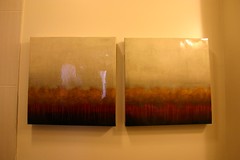On a recent trip to Montreal, the hotel room my wife and I booked was described as a “loft” and was likewise decorated with the requisite modern furniture and exposed brick walls. An offshoot of a very fine hotel located a few blocks away, our “loft” unit was comfortable and rather tastefully decorated. There were even original oil paintings on the walls, or so we initially thought.
After a few days in the room, something about the “artwork” didn’t sit quite right. It was all too homogeneous- the paintings in the bathroom (yes, above the toilet in a bathroom with no fan) and the ones above the bed and the desk all looked a bit too similar. We initially imagined that they had bought artwork from a local artist of limited creativity. My curiosity finally got the best of me, and I took one of the paintings off the wall and saw this:

Upon taking both the paintings in the bathroom off the wall, we discovered that they both held the same model number and were both “Made in China.” There was no artist’s signature, and they were clearly painted on a larger piece of canvas that was cut up and stretched over various wooden supports to create a number of smaller “artworks.”

I should not have been shocked. It’s not that I expect hotel rooms to have great art- they usually have some sort of sailboat or flower themed art above the beds that blends into the wallpaper. I think the shock in this particular example comes from the very fact that the hotel went to such great lengths to brand itself as hip, modern, and urban. By putting abstract oil paintings on thick stretcher bars in each room, it conveys the idea that it is some sort of “artist’s loft” that we had the good fortune to stay at for the week.
They got the image right, without actually having to spend time or money picking out the artwork. Similar to the “FCUK bodywash, Boconcept sofas, and Nespresso Citiz coffee machines” that Will Wiles mentions in his recent post titled Urbanism Sells, this mass-produced art tells guests that they are not staying at the Holiday Inn- they are having a hip and edgy https://onhealthy.net/product-category/stop-smoking/ time in a renovated loft.
When I returned home and started to look for this type of mass-produced art online, I quickly realized it was everywhere. You can easily by a large oil painting to hang over your sofa for $40 from places like Stock Oil Paintings, which is actually Shenzhen Fine Art Co., LTD. On the “about us” page they make no pretense of being a broker for Chinese artists, rather they describe themselves as “a professional manufacturer of oil paintings, sculptures, frames and other art crafts.” You can choose by style, color, or artist. Artist, of course, not meaning the person that actually painted it, but rather a knock-off of a famous artist. Want a copy (in oil) of a Modigliani for over your bathtub but you only have $52? You’re in luck.
As I scrolled through the various pieces of bargain-basement Chinese factory-made art, I came across an “Andy Warhol” for only $88! The irony of purchasing a copy of a copied painting made by one of Andy Warhol’s assistants in his original Factory that has been produced in an actual factory in China would not be lost on Warhol himself, I’m sure.
I really wanted to believe that there would always be a market for local artwork at places like boutique hotels- it seems we are told time and time again that the creative people are the ones who’s jobs can’t be outsourced-this is the type of theory advanced by Richard Florida in his book “The Rise of the Creative Class” (who’s also recently come under fire from the left in Toronto for being an elitist) and by many others who want to imagine we can ship all the unpleasant jobs off to China and keep the creative ones for ourselves.
The sad truth is that artwork, to most people, is something you hang on the wall that doesn’t clash with the furniture. The hotel’s interior designer saw no reason to buy oil paintings from working artists when a factory in China can crank them out for $40 or less each and they basically become disposable pieces of decor. You don’t have to actually be hip, or edgy, or an artist- not when you can buy into the image online for half the price of a week’s groceries.
Yep, that’s the sad truth – and what’s even worse is that with online vendors of “art” soliciting original work for reproduction from young working artist in return for either some sad menial amount of $ or store credit, there is little hope of the art market for anyone sans the very famous artists…glad I chose painting for my master’s degree – it’s too bad I cant submit designs for palatable hotel or even embassy art in return for US Dept of Education credits toward my loan payments 😛
I came across a similar thing photographing Travelodge rooms – which can you see some of here:
https://pentimento.squarespace.com/journal/category/-travelodge
The more I photographed them though the more I started noticing subtle differences – in the art work on the walls, the type of chair… Eventually, I stated to leave things in the room: small painting, calenders…